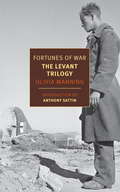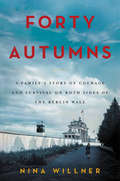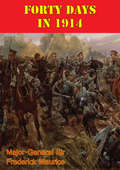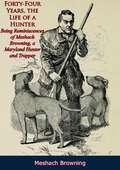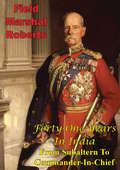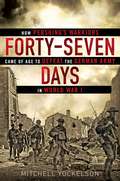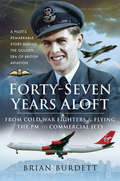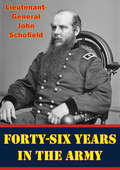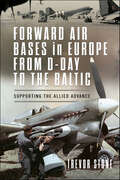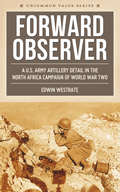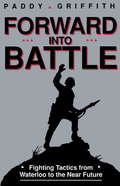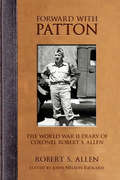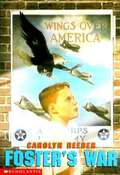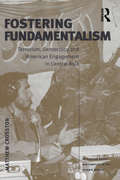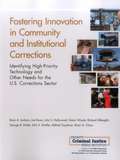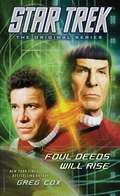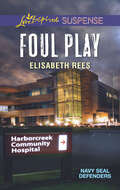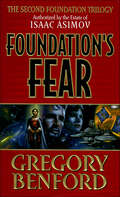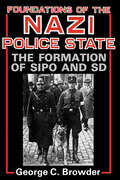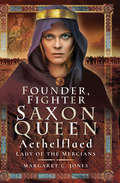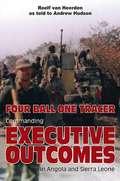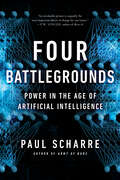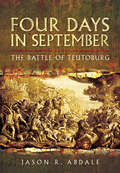- Table View
- List View
Fortunes of War: The Levant Trilogy
by Olivia Manning Anthony SattinIn The Levant Trilogy Olivia Manning returns to the story of the young English couple Guy and Harriet Pringle, last seen, at the end of The Balkan Trilogy, departing from Athens ahead of the invading Nazi army. Now, in the spring of 1941, they arrive in Egypt as Rommel's forces slowly but surely approach Cairo across the Sahara from the west. Will the city fall? In the streets the people contemplate welcoming a new set of occupiers, while European refugees and well-heeled Anglo-Egyptians prepare to pack their bags. And at night, everyone who is anyone flocks to the city's famed hotels and seedy cabarets, seeking one last dance before the tanks roll in. Manning describes the Pringles' ever complicated marriage and their motley group of friends and foes with the same sharp eye that earned The Balkan Trilogy a devoted following. And she also traces the fortunes of a marvelously drawn new character, Simon Boulderstone, a twenty-year-old recruit who must grapple with the boredom, chaos, and fleeting exhilaration of war.
Forty Autumns: A Family's Story of Courage and Survival on Both Sides of the Berlin Wall
by Nina WillnerIn this illuminating and deeply moving memoir, a former American military intelligence officer goes beyond traditional Cold War espionage tales to tell the true story of her family--of five women separated by the Iron Curtain for more than forty years, and their miraculous reunion after the fall of the Berlin Wall.Forty Autumns makes visceral the pain and longing of one family forced to live apart in a world divided by two. At twenty, Hanna escaped from East to West Germany. But the price of freedom--leaving behind her parents, eight siblings, and family home--was heartbreaking. Uprooted, Hanna eventually moved to America, where she settled down with her husband and had children of her own. Growing up near Washington, D.C., Hanna's daughter, Nina Willner became the first female Army Intelligence Officer to lead sensitive intelligence operations in East Berlin at the height of the Cold War. Though only a few miles separated American Nina and her German relatives--grandmother Oma, Aunt Heidi, and cousin, Cordula, a member of the East German Olympic training team--a bitter political war kept them apart. In Forty Autumns, Nina recounts her family's story--five ordinary lives buffeted by circumstances beyond their control. She takes us deep into the tumultuous and terrifying world of East Germany under Communist rule, revealing both the cruel reality her relatives endured and her own experiences as an intelligence officer, running secret operations behind the Berlin Wall that put her life at risk. A personal look at a tenuous era that divided a city and a nation, and continues to haunt us, Forty Autumns is an intimate and beautifully written story of courage, resilience, and love--of five women whose spirits could not be broken, and who fought to preserve what matters most: family. Forty Autumns is illustrated with dozens of black-and-white and color photographs.
Forty Days In 1914 [Illustrated Edition]
by Major-General Sir Frederick MauriceIncludes The First World War On The Western Front 1914-1915 Illustrations Pack with 101 maps, plans, and photos.In 1919 renowned military writer Major-General Sir Frederick Maurice set out to piece together how the German Schlieffen plan fell apart in the opening phases of the First World War. Using his extensive military background he deduced how the German High Command reacted to the opening clashes in 1914 and eventually recoiled after the Battle of the Marne. Still a fascinating read even after so many years, the details of the British and French commanders remain filled with the tension and drama as they sought to stem the seemingly unstoppable German juggernaut.
Forty Days with the Enemy
by Richard DudmanThis book is an interesting and detailed account of the 1970 capture, detention, and release of Richard Dudman, Elizabeth Pond, and Michael Morrow. Readers interested to know the fates of the many journalists lost in Southeast Asia would find the book very informative and absorbing.
Forty-Four Years, the Life of a Hunter: Being Reminiscences of Meshach Browning, a Maryland Hunter and Trapper [Illustrated Edition]
by Meshach BrowningMeshach Browning spent decades as a professional hunter and trapper of bears, boars and deer in rural Maryland during the early 1800s—this is his story, in his own words. Born in modest circumstances, Browning grew up at a time when the USA as a nation was in its infancy, with much of the population living in rural areas. From his youth, the author vowed to be self-sufficient, leaving his home and first love to hone his hunting skills. Returning with money gained from selling pelts and meat, it is then that Meshach contemplates hunting as a career. The equipment the author used is much inferior to today's. Meshach's use of a musket gun—whose reliability is demonstrated as poor in several instances—leads him to rely on his skills in close quarters combat. On multiple hunts, described with stunning vividness in these pages, Browning's ability to battle animals in melee saves his life. Dangers of his trade are balanced by its lucrativeness: bear meat and pelt for instance fetched high prices.-Print ed.
Forty-One Years In India - From Subaltern To Commander-In-Chief [Illustrated Edition]
by Field-Marshal Lord Roberts Of Kandahar V.C. K.P. G.C.B. G.C.S.I. G.C.I.E.[Includes over 140 maps, portraits and illustrations]Field Marshal "Bob" Roberts was one the most successful and well-loved generals of the British Army, decorated and distinguished in many actions and holder of the highest award for valour in action the Victoria Cross. He fought and commanded in Abyssinia, the UK and South Africa to great acclaim; however the majority of his life was spent on service in India and Afghanistan.His history and that of the British Raj entwined from his birth at Cawnpore in 1832 [modern day Kanpur] son of General Abraham Roberts, until he left India in 1895. Only a scant six years of service experience could not prepare the future Field Marshal for the irruption of the Indian Mutiny in 1857, in which he was conspicuous for his bravery and won his V.C.. Almost half of his autobiography is given over to the actions that he was involved in during the Sepoy Revolt; such as the siege of Delhi and the relief of Lucknow. He served in the second Anglo-Afghan War with distinction and received the thanks of Parliament; and commanded the punitive expedition to Kandahar in 1879 winning the decisive battle of Kandahar in September 1880. By this time he was a pillar of the British Empire and one of its foremost generals, and served on with distinction for many years in the sub-continent.An excellent, well-written memoir of a legend of the British Empire.
Forty-Seven Days
by Mitchell YockelsonThe gripping account of the U.S. First Army's astonishing triumph over the Germans in America's bloodiest battle of the First World War--the Battle of the Meuse-Argonne. The Battle of the Meuse-Argonne stands as the deadliest clash in American history: More than a million untested American soldiers went up against a better-trained and -experienced German army, costing more twenty-six thousand deaths and leaving nearly a hundred thousand wounded. Yet in forty-seven days of intense combat, those Americans pushed back the enemy and forced the Germans to surrender, bringing the First World War to an end--a feat the British and the French had not achieved after more than three years of fighting. In Forty-Seven Days, historian Mitchell Yockelson tells how General John J. "Black Jack" Pershing's exemplary leadership led to the unlikeliest of victories. Appointed commander of the American Expeditionary Forces by President Wilson, Pershing personally took command of the U.S. First Army until supplies ran low and the fighting ground to a stalemate. Refusing to admit defeat, Pershing stepped aside and placed gutsy Lieutenant General Hunter Liggett in charge. While Pershing retained command, Liggett reorganized his new unit, resting and resupplying his men, while instilling a confidence in the doughboys that drove them out of the trenches and across no-man's-land. Also explored are a cast of remarkable individuals, including America's original fighter ace, Eddie Rickenbacker; Corporal Alvin York, a pacifist who nevertheless single-handedly killed more than twenty Germans and captured 132; artillery officer and future president Harry S. Truman; innovative tank commander George S. Patton; and Douglas MacArthur, the Great War's most decorated soldier, who would command the American army in the Pacific War and in Korea. Offering an abundance of new details and insight, Forty-Seven Days is the definitive account of the First Army's hard-fought victory in World War I--and the revealing tale of how our military came of age in its most devastating battle.
Forty-Seven Years Aloft: From Cold War Fighters & Flying the PM to Commercial Jets
by Brian Burdett&“A journey through 47 years of aviation history through the memories of one pilot. From . . . &‘antics&’ in jet fighters, and civil aviation to retirement.&” —Vintage Airfix It all began for London-born Brian Burdett, as it has for so many, with the Air Cadets, flying Tiger Moths at the age of just fourteen. He obtained his civil license at the age of seventeen, and six months later he was accepted into the RAF. The year was 1954. It was to fly Hunters that Brian was posted to 257 (Burma) Squadron at Wattisham in Suffolk, where the jets were frequently scrambled to intercept Soviet intruders in the dark days of the Cold War. His RAF career developed further with a transfer to Transport Command where Brian could fly the planes he loved the best—the big jets. After training on Handley Page Hastings, Brian was given the chance to fly the famous de Havilland on long-distance routes between the RAF bases around the world, through the Middle East, Pakistan, Sri Lanka and down to South Africa and Australasia. He eventually turned to the commercial world, flying Falcons, VC 10s, Tristars and every type of Boeing 747, for a variety of airlines. His adventures are legion. From a double engine failure on takeoff and still managing to land safely, to losing control in cloud and leveling off feet from the ground, to a midair near miss with an American aircraft that no-one knew was there, to spotting a strange object that remains unidentified to this day. &“A fascinating career in military aviation and commercial aviation spanning 47 years . . . Highly Recommended.&” —Firetrench
Forty-Six Years In The Army [Illustrated Edition]
by Lieutenant-General John SchofieldIncludes Civil War Map and Illustrations Pack - 224 battle plans, campaign maps and detailed analyses of actions spanning the entire period of hostilities."John McAllister Schofield began his very successful military career after graduating seventh from the United States Military Academy in 1853.At the outbreak of the war, Schofield first served as mustering officer for the state of Missouri, received the promotion of major of the 1st Missouri Infantry, and served as chief-of-staff under General Nathaniel Lyon at the battle of Wilson's Creek. In January of 1864, Schofield led the Army of the Ohio during the Atlanta Campaign under William T. Sherman. When Sherman set off on his infamous "March to the Sea," Schofield and his command were left under George H. Thomas to stop the invasion of Tennessee led by Confederate General John B. Hood. On November 30, 1864, Schofield successfully repulsed John Bell Hood during the battle of Franklin, and effectively crippled Hood's army. Two weeks later, during the battle of Nashville, General Thomas used Schofield and his XXIII Corps to effectively destroy what was left of Hood's army. Schofield received a promotion to brigadier in the regular army for his actions at Franklin.Schofield was again moved to fight under Sherman in North Carolina. He captured Wilmington, and fought at the battle of Kinston before meeting up with Sherman on March 23, 1865 in Goldsboro. Working together with Sherman, Schofield led the Department of North Carolina until the surrender of Joseph E. Johnston at Durham Station. For his service, he was brevetted to major general in the regular army.After the war, Schofield went on to become the Secretary of War under President Johnson. He helped with the recommendation of making a naval base a Pearl Harbor, Hawaii, and eventually was promoted to lieutenant general."- CWT
Forward Air Bases in Europe from D-Day to the Baltic: Supporting the Allied Advance
by Trevor StoneThe largely sea-borne invasion of Northern France in June 1944, Operation Overlord, is acknowledged as one of the key actions which hastened the end of the Second World War. The RAF played a vital part in the landings. It then supported the subsequent advance of Montgomery’s 21st Army, and the Allies as a whole, through France, Belgium, Holland and into Germany. Following the breakout from the Normandy bridgehead in early August 1944, the RAF’s Second Tactical Air Force moved forward in support of the troops, occupying a number of temporary airfields as it went. The ground support for this operation was complex, a situation that was exacerbated by the fact that much of it had to be highly mobile. The advance, however, was rapid and soon ran into problems as the supply lines grew longer by the day. The planners had envisaged that capturing the Belgian port of Antwerp would eventually enable them to bring in vitally needed supplies much further north on the Continent. Although the city and its port were liberated in September 1944, the port’s route to the sea along the River Scheldt was still controlled by German forces. It took nearly three months until this was resolved, and the port opened for business. Until then, in the RAF’s equivalent of the US Army’s famed ‘Red Ball Express’, it was some 300 miles by road from Normandy with the Second Tactical Air Force largely reliant on the Army for transporting its needs. For an air force needing large volumes of fuel and ammunition, demand soon began to outpace supply. A number of emergency measures were put in place to keep the aircraft operational, which saw the RAF resorting to the use of its heavy bombers to fly in supplies. Even when Antwerp was up and running, supplying the Second Tactical Air Force remained a hand-to-mouth affair right through until the enemy’s surrender in May 1945. In Forward Air Bases in Europe from D-Day to the Baltic the author explores the challenges of supporting a mobile air force in those uncertain days as Hitler’s forces were retreating to their homeland. As the Allies found, things can go badly wrong when thinking loses touch with the art of the possible – logistics. In the end, miraculously, it worked, but it was a close-run thing.
Forward Observer
by Edwin WestrateForward Observer, first published in 1944, is the account of a U.S. Army artillery observation crew in World War Two. The author based the book on interviews with two surviving members of the crew while they were recuperating from injuries received after their prison ship was sunk in the Mediterranean (the men were being transferred to Italy from Africa, en route to a German prison camp). The account, fast-paced and filled with action, depicts the soldier's lives from training at the Army's Field Artillery School at Fort Sill, Oklahoma, a short stay for more training in England, and then the unit's transfer to Tunisia where they occupy the frontlines as forward observers for their artillery battalion. Forward Observer is a moving, personal story of a seldom-told aspect of combat in the Second World War. Included are 3 pages of maps.
Forward into Battle
by Paddy GriffinThe first edition (1981) took a critical look at the accepted wisdom of historians who interpreted battlefield events primarily by reference to firepower. It showed that Wellington's infantry had won by their mobility rather than their musketry, that the bayonet did not become obsolete in the nineteenth century as is often claimed, and that the tank never supplanted the infantryman in the twentieth. A decade later, the author has been able to fill out many parts of his analysis and has extended it into the near future. The Napoleonic section includes an analysis of firepower and fortification, notably at the Battle of New Orleans in 1815. Additional discussions of the tactics of the American Civil War have been included. The evolution of small-unit tactics in the First World War is next considered, then the problem of making an armored breakthrough in the Second World War. Following is a discussion of the limitations of both the helicopter and firepower in Vietnam. The author points to some of the lessons learned by the U.S. military and the doctrine which resulted from that experience. Concluding is a glimpse at the strangely empty battlefield landscape that might be expected in any future high technology conflict. From the Trade Paperback edition.
Forward with Patton: The World War II Diary of Colonel Robert S. Allen (American Warriors Series)
by Robert S. AllenThe WWII diary of a US soldier and Soviet spy who worked closely with General Patton is presented in this fully annotated edition.Robert S. Allen is one of the more controversial figures of the Second World War. After serving in France during World War I, he left the military to start a career as a syndicated columnist, eventually becoming the Washington, DC, bureau chief for the Christian Science Monitor. In that time, he also developed a sideline as a paid informant for the KGB.When American entered World War II, Allen rejoined the army to serve as General Patton's chief of situation and executive officer for operations. He was considered such an authority on Patton after the war that Twentieth Century-Fox asked him to develop a film script about the general.In Forward with Patton, John Nelson Rickard presents a complete, annotated edition of Colonel Allen's World War II diary for 1944-1945. The entries reflect Allen's private thoughts on the Third Army and provide an invaluable perspective on Patton, whom Allen deeply admired.
Foster's War
by Carolyn ReederSet in San Diego in 1941-42, this novel vividly evokes life on the home front, during World War II. As the U.S. battles tyranny overseas, 11-year-old Foster Simmons finds a way to make peace at home.
Fostering Fundamentalism: Terrorism, Democracy and American Engagement in Central Asia (US Foreign Policy and Conflict in the Islamic World)
by Matthew CrosstonIs the United States, in its fight against terror and pursuit of Osama Bin Laden, recklessly creating conditions in Central Asia to produce the next Bin Laden? Matthew Crosston studies this controversial argument in his political analysis of US foreign policy on Central Asia. He looks specifically at the 'no-man's land nexus' connecting Tajikistan, Uzbekistan and Kyrgyzstan and the heart of Central Asian Islamic radicalism - the Fergana Valley. This book breaks new ground by examining in unflinching detail the unwitting role US foreign policy plays in fomenting that 'hot zone' and extremism, producing a new generation of Islamic radicals. University courses that deal with US foreign policy, international security, terrorism and/or Eurasian politics will want to make this book required reading.
Fostering Innovation in Community and Institutional Corrections: Identifying High-Priority Technology and Other Needs for the U.S. Corrections Sector
by Richard Silberglitt Brian A. Jackson Brian G. Chow John S. Hollywood Dulani Woods Joe Russo George B. Drake John S. Shaffer Mikhail ZaydmanGiven the challenges posed to the U. S. corrections sector, such as tightened budgets and increasingly complex populations under its charge, it is valuable to identify opportunities where changes in tools, practices, or approaches could improve performance. In this report, RAND researchers, with the help of a practitioner Corrections Advisory Panel, seek to map out an innovation agenda for the sector.
Foul Deeds Will Rise: Foul Deeds Will Rise (Star Trek: The Original Series)
by Greg CoxAn all-new Star Trek novel, set in the popular and blockbuster Original Series movie era!2288. The U.S.S. Enterprise-A is on a vital peacekeeping mission in a remote solar system beyond the boundaries of the Federation, where two warring planets—Pavak and Oyolo—are attempting to end years of bitter conflict. Crucial peace talks are being conducted aboard the Enterprise, even as Starfleet weapons inspectors oversee the disarmament process. Losses and atrocities on both sides have left plenty of hard feelings behind, so Captain James T. Kirk has his work cut out for him, even as he unexpectedly runs into a disturbing figure from his past: Lenore Karidian. Twenty years ago, the deadly daughter of Kodos the Executioner tried to kill Kirk, but she has since been declared sane and rehabilitated. Kirk wants to give her the benefit of the doubt and a second chance at life, but when a mysterious assassination threatens the already fragile peace process, all clues point toward Lenore–and the future of two worlds hangs in the balance.
Foul Play: Mountain Hideaway Foul Play Fatal Reunion (Navy SEAL Defenders #2)
by Elisabeth ReesIn this inspirational romantic suspense adventure, a veteran Navy SEAL fights to protect his ex-fiancée from a deadly threat.After a failed attempt on her life, nurse Deborah Lewis knows her suspicions of foul play in the pediatric unit must be true. And her timely rescue by Cole Strachan—her ex-fiancé—allows her a second chance to prove it. The former navy SEAL who broke her heart is the last man she wants to see . . . but exactly the one she needs.Though Cole can’t give her the future he once promised, he makes a new vow to help her uncover the truth and stop the culprits. And he has to keep this promise, because more than Deborah’s heart is at stake—this time it’s her life.Praise for Foul Play“Rees’ latest installment in the Navy SEAL Defenders series quickly grabs readers and takes them along on an interesting game of cat and mouse. The resiliency of the hero and heroine demonstrates the resiliency of the human spirit in general. This is an action-filled keeper!” —RT Book Reviews, 4 1/2 stars TOP PICK!
Foundation for Integrating Employee Health Activities for Active Duty Personnel in the Department of Defense
by Christopher Nelson Elizabeth M. Sloss Gary Cecchine Gail Fisher Preethi R. SamaThe authors describe current Department of Defense safety and occupational health programs and health information systems, as well as employee health programs outside of DoD to provide a foundation for considering a more integrated Department of Defense employee health program.
Foundation's Fear (Second Foundation Trilogy #1)
by Gregory BenfordIsaac Asimov's Foundation Trilogy is one of the high-water marks of science fiction. It is the monumental story of a Galactic Empire in decline, and the secret society of scientists who seek to shorten the inevitable Dark Age with the science of psychohistory. Now, with the permission -- and blessing -- of the Asimov estate, the epic saga continues.Fate -- and a cruel Emperor's arbitrary power -- have thrust Hari Seldon into the First Ministership of the Empire against his will. As the story opens, Hari is about to leave his quiet professorship and take on the all but impossible task of administering 25 million inhabited worlds from the all-steel planet of Trantor. With the help of his beautiful bio-engineered "wife" Dors and his alien companion Yugo, Seldon is still developing the science that will transform history, never dreaming that it will ultimately pit him against future history's most awesome threat.
Foundations of the Nazi Police State: The Formation of Sipo and SD
by George C. BrowderA comprehensive study of the lesser-known organizations that formed the heart of the Nazi police state in World War II Germany.The abbreviation “Nazi,” the acronym “Gestapo,” and the initials “SS” have become resonant elements of our vocabulary. Less known is “SD,” and hardly anyone recognizes the combination “Sipo and SD.” Although Sipo and SD formed the heart of the National Socialist police state, the phrase carries none of the ominous impact that it should.Although no single organization carries full responsibility for the evils of the Third Reich, the SS-police system was the executor of terrorism and “population policy” in the same way the military carried out the Reich’s imperialistic aggression. Within the police state, even the concentration camps could not rival the impact of Sipo and SD. It was the source not only of the “desk murderers” who administered terror and genocide by assigning victims to the camps, but also of the police executives for identification and arrest, and of the command and staff for a major instrument of execution, the Einsatzgruppen.Foundations of the Nazi Police State offers the narrative and analysis of the external struggle that created Sipo and SD. This book is the author’s preface to his discussion of the internal evolution of these organizations in Hitler’s Enforcers: The Gestapo and the SS Security Service in the Nazi Revolution.“A welcome addition to the literature on National Socialist Germany.” —American Historical Review“Sheds new light on Himmler’s role in the complex web of the Nazi police state.” —Publishers Weekly“[The book] makes major changes in our understanding of the structure and functioning of the Nazi police state.” —Canadian Journal of History“This is the first comprehensive study of how the Gestapo and all other detective police came to be united under the Sipo (Security Police) and tied to the SD (The Security Services of the Party and SS).” —Educational Book Review“The work fills an important gap in the literature on the Third Reich.” —TheHistorian
Founder, Fighter, Saxon Queen: Aethelflaed, Lady of the Mercians
by Margaret C. JonesThe story of the daughter of Alfred the Great, who fought against Viking invaders and ruled a kingdom in the tenth century. Alfred the Great’s daughter defied all expectations of a well-bred Saxon princess. The first Saxon woman ever to rule a kingdom, Aethelflaed, Lady of the Mercians, led her army in battle against Viking invaders. She further broke with convention by arranging for her daughter to succeed her on the throne of Mercia. To protect her people and enable her kingdom in the Midlands to prosper, Aethelflaed rebuilt Chester and Gloucester, and built seven entirely new English towns. In so doing she helped shape our world today. This book brings Aethelflaed’s world to life, from her childhood in time of war to her remarkable work as ruler of Mercia. The final chapter traces her legend, from medieval paintings to novels and contemporary art, illustrating the impact of a legacy that continues to be felt to this day.
Four Ball One Tracer: Commanding Executive Outcomes In Angola And Sierra Leone
by Roelf Van Heerden Andrew HudsonBrutally honest and devoid of hyperbole, this is Roelf van Heerden's Executive Outcomes. Unapologetic, unassuming and forthright, the combat exploits of Executive Outcomes (EO) in Angola and Sierra Leone are recounted for the first time by a battlefield commander who was physically on the ground during all their major combat operations. From fighting UNITA for the critical oil installations and diamond fields of Angola to the offensive against the RUF in Sierra Leone to capture the Kono diamond fields and the palace coup which ousted Captain Valentine Strasser, van Heerden was at the forefront. He tells of the tragedy of child soldiers, illegal diamond mining and the curse of government soldiers who turn on their own people; he tells of RUF atrocities, the harrowing attempt to rescue a downed EO pilot and the poignant efforts to recover the remains of EO soldiers killed in action. Coupled with van Heerden's gripping exposé, hitherto unpublished photographs, order of battle charts and battle maps offer unprecedented access to the major actions as they took place on the ground during the heydays of EO.
Four Battlegrounds: Power In The Age Of Artificial Intelligence
by Paul ScharreAn NPR 2023 "Books We Love" Pick One of the Next Big Idea Club's Must-Read Books "An invaluable primer to arguably the most important driver of change for our future." —P. W. Singer, author of Burn-In An award-winning defense expert tells the story of today’s great power rivalry—the struggle to control artificial intelligence. A new industrial revolution has begun. Like mechanization or electricity before it, artificial intelligence will touch every aspect of our lives—and cause profound disruptions in the balance of global power, especially among the AI superpowers: China, the United States, and Europe. Autonomous weapons expert Paul Scharre takes readers inside the fierce competition to develop and implement this game-changing technology and dominate the future. Four Battlegrounds argues that four key elements define this struggle: data, computing power, talent, and institutions. Data is a vital resource like coal or oil, but it must be collected and refined. Advanced computer chips are the essence of computing power—control over chip supply chains grants leverage over rivals. Talent is about people: which country attracts the best researchers and most advanced technology companies? The fourth “battlefield” is maybe the most critical: the ultimate global leader in AI will have institutions that effectively incorporate AI into their economy, society, and especially their military. Scharre’s account surges with futuristic technology. He explores the ways AI systems are already discovering new strategies via millions of war-game simulations, developing combat tactics better than any human, tracking billions of people using biometrics, and subtly controlling information with secret algorithms. He visits China’s “National Team” of leading AI companies to show the chilling synergy between China’s government, private sector, and surveillance state. He interviews Pentagon leadership and tours U.S. Defense Department offices in Silicon Valley, revealing deep tensions between the military and tech giants who control data, chips, and talent. Yet he concludes that those tensions, inherent to our democratic system, create resilience and resistance to autocracy in the face of overwhelmingly powerful technology. Engaging and direct, Four Battlegrounds offers a vivid picture of how AI is transforming warfare, global security, and the future of human freedom—and what it will take for democracies to remain at the forefront of the world order.
Four Days in September: The Battle of Teutoburg
by Jason R. AbdaleThe author of The Great Illyrian Revolt examines one of the Roman Empire's most pivotal defeats—a surprise attack by Germanic barbarians in 9 AD. For twenty years, the Roman Empire conquered its way through modern-day Germany, claiming all lands from the Rhine to the Elbe. However, when at last all appeared to be under control, a catastrophe erupted that claimed the lives of 10,000 legionnaires and laid Rome's imperial ambitions for Germania into the dust. In late September of 9 AD, three Roman legions, while marching to suppress a distant tribal rebellion, were attacked in a four-day battle with the Germanic barbarians. The Romans under the leadership of the province's governor, Publius Quinctilius Varus, were taken completely by surprise, betrayed by a member of their own ranks: the German officer and secret rebel leader, Arminius. The defeat was a heavy blow to both Rome's military and its pride. Though the disaster was ruthlessly avenged soon afterwards, later attempts at conquering the Germans were half-hearted at best.Four Days in September thoroughly examines the ancient sources and challenges the hypotheses of modern scholars to present a clear picture of the prelude to the battle, the fighting itself and its aftermath.
